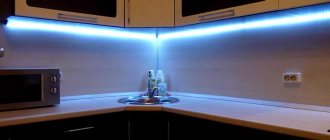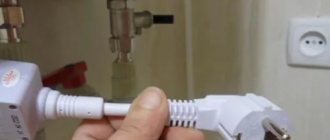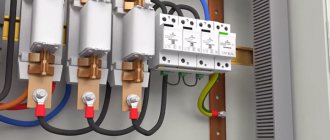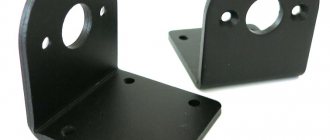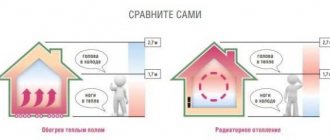Installing sockets in concrete is a responsible task that requires care, compliance with safety precautions and certain skills.
The work process consists of several stages and includes marking the surface, making grooves, laying wires, installing socket boxes, fittings and finishing work.
Classification of sockets by installation type
In total, it is customary to distinguish two main types of these devices:
1. Overhead models.
Mounted directly on the wall surface. They also received the name “external” due to the installation method. The devices themselves can be easily combined with any type of surface. Transferring products from one place to another will also not be difficult if necessary.
2. Built-in.
During installation, the use of so-called landing nests is assumed. It is not difficult to place an internal outlet in a concrete structure.
The second type raises the most questions among masters. Planting nests are also called socket boxes. The standard depth of the socket box is 45 mm, but there is also a recessed version of 60 mm. It is recommended to use it if you plan to connect wires inside the structure. Then the sockets on the surface do not deteriorate.
The nuances of installing a multibox on a plinth
What should you do if your house has already undergone high-quality repairs, but you need another point to connect electrical household appliances?
In this case, it is not at all necessary to rip off the new wallpaper and ditch the wall; you can make a socket directly on the baseboard.
Multiboxes fit all types of standard single sockets. They can accommodate not only electrical, but also telephone sockets, as well as Internet cable connectors.
However, it should be noted that this method can only be used on collapsible plastic skirting boards with a cable channel. Before installing the socket box, it is necessary to lay the wire inside the baseboard.
To do this, remove the cover from the part where the socket will be located. This operation is performed from a corner or from a nearby plug; simply pry the cover with a screwdriver and carefully remove it.
Cut the baseboard so that there is a gap the width of which matches the size of the plastic trim. Insert the multibox into it, thread the wire through the hole in its body, and secure the socket box with dowels.
Preparatory work
The process begins with the preparation of the materials themselves, the basic tools. You need to understand exactly in which areas the sockets are installed. The installation locations of the devices are marked on the diagram, which is prepared in advance. The same applies to lines with wires and switches. Without this, an internal outlet cannot be placed in a concrete wall.
30-40 centimeters from the floor is the standard height of sockets when it comes to residential buildings. In other cases, the parameter is selected individually, depending on the characteristics and purpose of the room itself.
Additional rules must be observed when laying out the wires for the socket:
· Distance from the ceiling – at least 15-20 centimeters.
· Wires diverge only along horizontal and vertical planes. Diagonal laying is prohibited according to current regulations. The same applies to creating twists between different parts, zigzags.
· 35 centimeters – minimum distance between grooves and pipeline. With a hidden type of installation - including.
Installation of accessories
After finishing the finishing work, we begin installing the socket mechanisms. Before starting work, check that there is no power in the network. It is recommended to shut off the current supply directly at the distribution board. To do this, you need to turn off the circuit breakers.
We connect wires to the socket depending on the type of socket (screw, spring). Here we will look at installing a socket with spring terminals.
We prepare the wires by removing the outer protective sheath of the power cable. We strip the ends of the cores by 10 - 12 millimeters. We direct the wires to the terminals of the socket mechanism. We insert the yellow-green ground wire into the central terminal, send the blue wire (zero) to the left terminal, and connect the white wire (phase) to the right terminal.
Working with wiring requires certain qualifications, and it is not recommended for non-specialists to undertake it. However, if you have basic knowledge of electrical engineering and the necessary tools, then, subject to safety precautions, it is quite possible to independently install an outlet in a concrete wall.
Marking
An axial center is marked on the concrete wall to place the wires. A pencil and tape measure will do the job. A certain distance between different mechanisms is needed in case adjacent sockets or entire blocks of devices are later installed. 7.1 centimeters is the recommended interval. This is the average distance for socket boxes, center-to-center.
You need to draw two axes in the center - one horizontal, the other vertical. Installation of structures will be as smooth as possible only with sufficient length of the lines. Replacing the socket box in this case is also not a hassle.
Installation in drywall
For this process we will need the following tools:
- Drill or screwdriver.
- Drywall bit (Ø 67 mm) is a special drill attachment used for cutting holes.
A set of crowns of various diameters for working with drywall.
As a last resort, if there is no such attachment, then the holes can be cut with an ordinary stationery knife, but this is not recommended. On the other hand, you can do without a drill or screwdriver.
- A screwdriver (with its help, the socket is disassembled and assembled, and the “glass” is screwed on).
First of all, we should install the socket box, this is done as follows:
- We install the bit with a crown on the screwdriver (drill), and then cut a hole in the marked place.
- We break out the plug for the wire in the mounting socket, and then insert the electrical wires there.
- We insert the “glass” into the drywall and tighten the clamping screws (marked in green in Fig. 1).
When the socket box is installed, you can begin finishing work, and upon completion, we continue with the installation of the built-in electrical point. The sequence of actions is as follows:
- We disassemble the structure into elements; as a rule, it is enough to remove the front panel.
- Connect the wires to the terminals.
- We install the base with the mechanism in the “glass”, set it level, and then fix it.
Fixing the socket - Screw on the front panel.
Making holes
Holes in the wall are created in three ways:
· Using a grinder or angle grinder.
· Impact drill, hammer drill or pobedit drill.
· Special crowns for working on concrete. They will also help those who are interested in installing a triple socket.
First option (crown for concrete)
This method is one of the most popular and is widely used in practice. A concrete crown is placed on a hammer drill; this is a special device for making holes. It will be useful for those who are interested in how to embed a socket into a concrete wall.
The cutting element of the tool is a part supplemented with diamond coating. They are also allowed to do the work using pobedit nozzles. When creating devices, only materials of increased strength are used, allowing them to destroy any surface. The result is an even cut with a round shape. A drill on a concrete wall is placed in the inner part of the nozzle. Centering the cutting element is the main purpose of the drill itself. Everyone can figure out how to seal holes.
The dimensions of the drill itself must be large compared to the dimensions of the socket box for installation.
The work order is described as follows:
1. The drill is placed at a given point.
2. The beginning of immersion of the crown into the material.
3. The remaining concrete after completing the cut is hollowed out.
4. For this stage, indispensable assistants are a hammer and a chisel.
Second option (drill, hammer drill, pobedit drill)
A pobedite drill is suitable if the previous tools are not at hand. It is recommended to use hammer drills to make holes. An impact drill also copes with such operations without problems. But under such circumstances the process becomes more complicated. It’s not that easy to work on a wall with your own hands.
The circle is drilled based on the line created in advance. Step is the minimum possible indicator. Immersion at depth is easier to control using electrical tape tied to the drill. Using a hammer and chisel, the finishing touches are completed. How to fix a socket in the walls is an easy and understandable question.
Third option (Bulgarian)
With round holes, an angle grinder cannot be called the most suitable option. It does a better job of creating square shapes. But you can choose this option if there are no other devices. This is one of the answers to the question of how to make a rosette in a concrete wall.
The main thing is to choose a special type of disc designed for concrete work. Draw the shape of a square, not a circle. 4 cuts are made along the marked lines in the wall. Their dimensions are larger than the dimensions of the socket box. A hammer and chisel are used to get rid of the remaining building material. Installing a triple socket involves the same rules.
What tools do you need to prepare?
Before installing the outlet, you should prepare the following tools and parts - they will be needed in this order:
- A pencil, marker, charcoal, or anything that can be used to make markings on the wall.
- Ruler. Even an ordinary school one is suitable for one device, and if a block of sockets is installed, then preferably a large one.
- Level – bubble or laser. At the initial stage, it will only be useful when installing the socket block.
- Drill with a “concrete bit” attachment. If you don’t have an attachment, a concrete drill will do. Some people cut the wall with a grinder. If the wall is particularly strong, then water will not hurt, as it will cool the crown.
- Chisel and hammer - needed for fine adjustment of the walls of the hole.
- Socket box – provides rigid mounting of the device in the wall.
- Putty - gypsum, alabaster or cement mortar.
- A spatula that can be placed in a socket box.
- A voltage indicator - by and large, could be useful at the beginning, but you cannot do without it at this stage.
- Additional wires are needed if several points are being installed.
- Knife – maybe the smallest one.
- Pliers – preferably with wire cutters.
- The socket is what everything is started for.
- A screwdriver - most often a Phillips screwdriver, but in some cases a slotted one is also useful - it all depends on the bolts that need to be tightened.
It is assumed that before installing the socket in the wall, wires have already been laid to this place and it is known which of them is the phase and where the neutral is with grounding. If not, then you will have to plan large-scale work to punch grooves (grooves) in the wall for wiring. To do this, you will have to rent a wall chaser, prepare to drill them out with a drill and hammer drill, or cut them out with a grinder.
The experience of punching grooves in concrete with a hammer and chisel is guaranteed to be superfluous - possessing such knowledge will never compensate for the time spent on acquiring it.
Holes and size of socket box: customization
After making the holes, you need to check whether the socket boxes are suitable for them. Initially, the holes have a larger diameter compared to devices. Therefore, choosing the correct width is not difficult. Adjusting the desired depth is part of the work that requires additional effort. Otherwise, it is impossible to fully understand how to install a socket box in the wall.
The ideal option is depth, when the socket itself in the concrete wall goes deep into the niche, 5 millimeters. But it is recommended to make a small reserve - taking into account the possible use of fixing materials inside the holes. Usually this is a solution of gypsum or alabaster. The bend of the wire going to the device also takes up a certain space.
Trimming the edges makes the job easier. This is easy to do with a knife.
Adjusting the depth will result in both the outer skirt and the socket box being hidden inside the hole. Then the device is mounted in the same plane with the wall. Otherwise, gaps of 1-2 millimeters appear.
Differences between old and new outlets
Switches installed in walls are attached using the same principle, but they fall out much less often. The reason is simple - when turning it on and off, the force is always applied in the direction of the wall. In sockets, everything is different - when the plug is inserted into them, the force is directed towards the wall, and when it is removed, it is directed back.
In older outlets, this problem was not so acute, because they were designed for devices with much lower power consumption. This automatically meant that there were no strict requirements for the pressing force of the contacts - plugs were inserted and removed from sockets with much less effort - from that time on, many users began the habit of pulling the plug by the cord. Removing the plug in this way is prohibited now and was not allowed before, but with the old sockets there was enough safety margin, so often such requirements were simply not paid attention to.
Modern sockets use spring-loaded contacts, which are pressed very tightly against the live parts of the plugs. Even a socket installed according to all the rules will gradually become loose, so it is recommended in any case to hold it with your hand when removing the plug.
Wiring
This description of the work is for those who are interested in how to install a socket box in concrete. You can't do without wires:
· Checking insulation and cable cores for various defects.
· Removing the cover from the distribution box.
· A cable is placed inside the box, its different ends. They enter it from one side, and from the other they go to the landing box. It is better to route the cable with an additional margin, then it will be easier to work in the future. Usually it is 10-15 centimeters.
· A groove intended for the wire is prepared at the top. There should be no obstacles on the side of the wire, the movement of the socket box inside the niche should be free. The device is equipped with a special slot on the reverse side, with the help of which installation is completed.
· A corrugated pipe is laid inside the grooves, inside of which there is a cable.
· Additional fixation is provided with alabaster mortar. 250 millimeters is the step that is recommended to be followed.
· Defects are easily covered with putty-type solutions. How to cover the socket boxes in this or that case is up to the owner to decide.
Gypsum can also be a good fixing compound. Both construction and medical varieties are used. The base is poured into a container when the solution is just starting to be prepared. After this, add water, a small amount. The density of the solution should be medium.
After a couple of minutes, working with the composition becomes more difficult, so you need to use it quickly. After 5 minutes the compounds become completely unusable. Let's look further at how to install a socket box in a concrete wall.
Tools and consumables
A set of tools and materials necessary for installing socket boxes in concrete surfaces:
- electric hammer drill equipped with an SDS Plus or SDS Max chuck;
- a drill designed for drilling walls in concrete (diameter from 5 to 8 mm, length from 60 mm);
- safety glasses and mask;
- chisel and hammer (you can use a special steel blade for a hammer drill);
- bit for drilling concrete surfaces, equipped with an SDS Plus or SDS Max shank;
- a special bit with diamond cutting edges (used for hammerless drilling of concrete surfaces);
- spatula for applying gypsum mixture;
- container for mixing the mixture;
- dry solution (the mass of the substance depends on the expected amount of work);
- drill mixer used when mixing the solution.
It is necessary to install socket boxes after laying the wiring; it is allowed to run an additional cable to the installation site. In concrete walls, cables are laid in channels (grooves) of rectangular cross-section, cut into the wall. To make grooves, a special tool (wall chaser) is used, equipped with a window for removing generated dust with a construction vacuum cleaner.
Preparation and installation of socket boxes
The electricity supply must be turned off before starting work. The box and the hole are tried on against each other. The socket box should be flush with the surface, there should be no obstacles to this. If there are unnecessary elements, they are cut off and removed.
The bottom of the hole is cleaned of any traces of dirt and dust. After this, they prime the surface. Under such circumstances, the adhesion of the fixing composition and the wall will be optimal. You will have to wait a while for the primer to dry.
The further procedure for the work is as follows:
1. Plastic elements are squeezed out of the box. Then the cable runs through here.
2. Treatment of the walls and bottom of the recess with a solution for specialized purposes. This is also required for the outer part of the socket box in a concrete wall.
3. Installation of the device, block in the solution. It is important to align the edge of the socket box on top and the wall with each other.
4. Use a building level to check how horizontal the mounting lugs are.
5. The box is removed from excess solution. This rule also applies to a triple rosette in any surface.
Structural adapters are used when connecting when a whole block with sockets is mounted.
DIY socket block installation
All steps to install a group of power points are performed in strict sequence.
Wall marking
Perform using a building level or a ruler with a marker. Future channels should be located only vertically or only horizontally. It is forbidden to make slanting grooves for laying cables
It is important to accurately mark the locations for installation of socket boxes. There must be strictly 72 cm between their central parts
Otherwise the boxes will not fit into place.
Grilling
Grilling walls for sockets
The preparation of channels for cable laying can be done with a hammer drill, grinder, chisel and hammer. Each master chooses a method for himself, depending on whether he has a particular tool.
The principle of forming a groove looks like this:
- Using a grinder, a cut is made on both sides along the marking line. If the master works with a hammer drill, holes are made in steps of 1.5-2 centimeters along the line.
- Using a hammer and chisel, excess concrete is knocked out of the wall, forming channels for laying wiring.
- Technical recesses for installing socket boxes are made using a hammer drill with a crown. Here they also cut the concrete and then knock out the excess with a chisel and hammer. If necessary, select the depth of the excavation. Periodically insert the socket box into the concrete, checking how far its edges protrude above the plane of the wall. The norm is considered to be some deepening of the elements inward. Later, the excess free space will be filled with building mixture.
Installation of socket boxes
Built-in socket boxes must be flush with the wall
To install a set of socket boxes, it is advisable to buy special plastic cups for them. The elements are fixed in the nests using alabaster or gypsum mortar. It is prepared from bulk material, mixed with water in a ratio of 4:1. The consistency should look like thick sour cream.
The finished solution is placed in a socket on a concrete wall and, having released wires into the technical gaps of the glasses, they are mounted into the wall
It is important to monitor the evenness of the glasses using a level. It is unacceptable if they protrude above the plane of the wall
Using the remaining building mixture, the wall around the future block is leveled as much as possible.
The solution sets in about 2-4 hours. To be sure, you can give it a day to dry.
Features of installing socket blocks in drywall
Installing sockets in drywall requires care
If the overhead socket box needs to be built into a plasterboard wall, less labor can be spent here. The socket block has special claws that you simply need to press onto the sides of the gypsum board box. In turn, the outer protrusion-rim of the glass simply will not allow it to fall inward. If the wall is to be tiled in the future, the element must protrude above the plane of the wall by the thickness of the facing material.
When forming a nest for glasses, it is advisable not to press too hard on the wall so as not to break it. Drywall is a relatively fragile material.
Features of installing a double socket box
To connect socket boxes into a concrete wall, use special connectors. Such designs are also called butterflies. The connectors are placed to connect the butterflies on the sides. Thanks to this, you can connect both 2 socket boxes and a much larger number.
The work is carried out in the following order:
· First make the markings. It is necessary to count the distance from the floor to one or another element. The strip is strictly horizontal, with a certain height. Then installing a socket box in a concrete wall will not be difficult.
· The socket boxes are applied to the strip, already connected by a butterfly. The central parts of each device must be marked on the strip.
· Create holes using one of the methods described earlier.
· Connecting grooves are created between the holes. A suitable tool for this is a grinder.
· Immersion of the wire inside one of the holes.
· After this, work proceeds as usual. It’s easy to figure out how to install a socket box in a concrete structure.
Preparation stage
Before you begin installing sockets in concrete, you need to decide on the installation location, as well as prepare the tools and materials that will be needed during the work. When installing sockets in residential premises, it is worth remembering two main factors:
- Installation of sockets in living rooms (living room, bedroom) is carried out at a distance of 30–40 cm from the floor.
- When installing in other rooms (kitchen, bathroom), you should rely only on personal preferences. That is, where it will be convenient and practical, put it there.
When laying electrical wiring, you need to remember some rules:
- The wires are installed at a distance of about 15–20 cm from the ceiling.
- Wire laying is carried out only in a horizontal or vertical position. Under no circumstances is laying diagonally or otherwise allowed.
- The groove for laying the wire (groove) must be at a distance of at least 35 centimeters from the gas pipeline pipe.
Before starting work, you need to prepare a workplace, as well as tools that will be useful during installation.
Marker, chalk, pencil, or anything to mark the outlet hole in the concrete. Ruler of any size. A level of any type, which is useful for installing several sockets in one place. Drill with installed bit for concrete surfaces. If there is no special crown, you can simply use a drill. In some cases, with certain skills, a grinder is used
It is important to remember that the drill or bit can become very hot during operation and must be cooled down regularly. Hammer with chisel. This tool is necessary to give the groove the correct shape. Socket box
This item is a frame that gives the mount greater rigidity. Putty of any kind, for example, gypsum or cement. You will also need a spatula, which will be placed in the socket box. Standard set of tools: knife or cutter, flat-head and Phillips screwdriver, pliers.
After mastering some rules and preparing the instrument, we proceed to the next step.
Electrical connection
Only two or three wires are required to connect. The main thing is to avoid mistakes during this stage. Installing an outlet block into a concrete wall requires additional supervision.
First you need to make sure that there is no electricity flowing through the wiring. Turning off the circuit breaker is a simple task that only takes a minute or two. For checking, special indicator screwdrivers are often used. Thanks to this stage, further work is greatly simplified.
The so-called wire stripping also becomes an obligatory part. 1.5-2 centimeters are removed from the ends of the veins. The piece that turns out to be bare is bent into a ring shape. For multi-core products, the structure is divided into two parts. Then the ends of the wires take on the shape of the letter V. The installation of socket boxes in the structure is simplified.
The core is slightly flattened with pliers. The result is an increased contact area between the wires and the terminal.
Connecting wires also has features that must be taken into account.
· The socket is equipped with only two terminals of current-carrying contacts. The third is for grounding.
· All parts are clamped with special bolts, which means there is not enough space to insert larger wires.
· The yellow-green wire usually goes to the ground pin. This rule is easy to follow if the coloring of the material is initially organized correctly.
· Blue – to zero, the rest – for phase.
· Grounding is connected only to the contact that is intended for it.
· The phase with zero is connected to the remaining components. Then the order in which the work is done practically does not matter. In any case, it is easy to understand how to install a socket box in the walls.
A cable or star is a way to connect a block with sockets. If a cable is used, wires from the previous one go to the contacts of one socket. After this, move on to the next component.
The second diagram with an asterisk is slightly different from the previous one. From each outlet, the wires are collected at a “common collection point.” After this, everything is connected in order. Connecting grounding with a loop is prohibited, according to current regulations. Only phase and neutral can be connected in this way. The “earth” must be brought down with the help of a star. After this, the installation of socket boxes in the wall is almost complete.
What to do if the socket itself falls out
There may be two main reasons for this - insufficient pressing of the fastening tendrils and the smooth inside of the socket box, along which the fastenings simply slip.
In the first case, the fasteners simply do not reach the walls of the socket box or the pressing force is insufficient to confidently hold the entire structure. This may occur due to wear of the fasteners or mismatch of models, when the socket itself is smaller than the socket box.
If the socket is still fixed in the socket box, but is then pulled out of it along with the plug, then it lacks quite a bit of pressing force. Here it will be enough to simply bend the fastening antennae a little - they are shaped like the letter “G”, but with the upper part slightly bent upward. If you bend it a little more, the pressing force will increase. To do this, you need to unscrew the adjusting bolt; this part will fall out of the socket itself and can be adjusted with pliers. Then everything can be installed in reverse order. To ensure a guaranteed result, you can make several notches in the place where the fastening antennae will rest, using a knife or a soldering iron.
When the socket itself, even if well fixed in the wall, is much larger than the socket, then it is necessary either to change it completely or, again, to make choppers and make notches on the inside.
There are also often cases when the surface of the socket at the point of contact with the spacer antennae is simply licked off. An effective solution is to remove the socket box and then install it, but at an angle of 90° from the original position. It’s even easier to rotate the socket itself - double and triple ones are often installed this way - in a horizontal position.
Before deciding what to do if the socket falls out of the socket box, you need to inspect the body of the latter - modern models have mounting bolts with which the socket is simply screwed to their body.
Finishing
Finishing work begins only after the fixing material has completely dried. Otherwise, there is a high risk that the mounted device will move to the side. We have already figured out how to install a socket in a concrete wall.
The working surface is finished as follows:
1. Irregularities, chips and holes - any noticeable defects - are treated with special primers. It is recommended to properly level the surface around the socket boxes in the concrete wall again.
2. Puttying of the surface begins after the previous layer has dried. The surface is sanded when the putty is dry. The main thing is that the resulting base is as smooth as possible.
3. Apply another layer of primer and wait until it dries. Then the rosettes on the surface look more attractive.
Installing a socket in a concrete or brick wall
To install a socket or switch in the wall, you will need a special box called a socket box.
To install it in a concrete or brick wall you need to do the following:
- prepare the necessary tools and materials;
- make markings on the wall where the socket is installed;
- drill holes in the wall;
- install socket boxes.
From the tool we take:
- perforator;
- special crown for drilling with a diameter of 70 mm;
- level;
- pencil;
- putty knife.
Let's take from the material:
- socket boxes;
- self-tapping screws;
- construction alabaster;
- water.
First, we mark the installation location of the sockets. The distance from the floor in residential areas is described in the article on installing electrical wiring.
For example, we will install a block of three socket boxes. This will make the essence of the installation clearer.
In fact, setting the number of sockets is regulated by you. Install as many as you need: one, two, three, four or five. More, with a single three-wire wire, does not make sense, and it is not safe.
If you need more, make a separate group of sockets with another three-wire power wire.
You need to buy socket boxes that have special grooves for connecting them together. Connect the socket boxes to each other.
If you measure the distance from the middle of one socket box to the middle of another, you get a distance of 71 mm. Remember this distance. It will come in handy when you mark and measure the drilling location.
We make a template for marking. To do this, screw a self-tapping screw into the center of each socket box. The self-tapping screw can be any:
Having marked the desired place, we mark the level with a pencil:
Then, leaning a block of three socket boxes against the wall, we make scratches with self-tapping screws from bottom to top, and after the scratch we finish drawing with a pencil. This will be the drilling location.
The work will be dusty. Let's start drilling. We insert the crown into the hammer drill and drill three holes to the desired depth.
Next we work with a spatula, setting the hammer drill to chiselling:
First, use a brush to sweep away all the dust from the drilling areas:
We try on and check the plane so that the socket boxes do not protrude from the wall. Be sure to soak the drilling area with water and once again try on and install the socket boxes using construction alabaster:
If all the sockets are 220 V, then the wire that you will put into the box should be with the end one, which will help to avoid connection problems.
Wires, when connecting sockets, can be routed in a cable, from one box to another through holes made in advance when connecting the boxes to each other.
Conclusion
Thus, you learned how to install sockets in the wall using boxes. This is one installation method, but there are others, such as cutting out the location of the sockets in a concrete or brick wall using a manual corner cutter. But that's another story.
Connection features (electrical part)
Before starting this stage of work, you must make sure that the electrical wiring is de-energized. That is, go to the input panel and turn off the machines, if this has not been done previously. In addition, according to safety standards, it is required to hang a sign “Do not turn on people working!”, but in everyday life this requirement is usually ignored. In any case, it would be a good idea to warn your family, and it would be better to lock the electrical panel.
After the safety standards have been met, you can begin connecting. First of all, it is necessary to trim off the excess wire, leaving about 10 cm. The ends are stripped; it is advisable to use a special tool for this purpose - a stripper; it allows you to quickly remove the insulation without damaging the current-carrying conductor (TCC). If you don’t have one, you can use a knife to strip wires; in extreme cases, an ordinary stationery knife will do.
If stranded wires are used in the wiring, their ends must be crimped or tinned. In everyday life, this requirement is often ignored, which is fundamentally wrong, since the likelihood of loose contact increases, which can cause a fire. Therefore, do not be lazy, at least tin the ends of the wire. If you use a cable with a monolithic TKZh, there is no need to tin or crimp the ends.
Next, the prepared wires are connected to the corresponding contacts; the connection diagram for a network with and without grounding is presented below.
Connecting the socket to the network without grounding (A) and with grounding (B)
Accordingly, grounded electrical points (B in Fig. 12) can be used in both options.
If a group of sockets is connected, they must be connected in parallel, and the grounding wire must be supplied from a common point, as shown in the figure below.
Connecting a group of outlets
This is done so that if the ground “burns out” on the first outlet, other electrical points in the group are not left without grounding.
When connecting, it is important to make sure that the wires in the clamp are well tightened, otherwise the contact will be broken, as described above.
As for the standard regulating the location of zero and phase in sockets, it does not exist, but it is considered good form when all connections in an apartment or house are made in the same way.
Connection methods taking into account consumers
A block of sockets of one group is connected using a daisy chain method. It involves connecting all elements of the group to a common power supply line. The circuit created by the daisy chain method is designed for a load that does not exceed 16A.
Today, connecting a block of sockets is often carried out in a combined way, which is based on a parallel circuit. This method is actively practiced in European countries. We use it to provide a separate line for powerful consumers.
Parallel connection involves laying two cables from the junction box:
The good thing about this method is that it ensures the functionality of a single point and makes it independent of the functioning of other nearby participants in the chain.
The only drawback of the scheme is the increase in cable consumption and labor costs for the electrician.
Both daisy chain and combined connection methods can be closed or open. The first involves hollowing out channels in the wall to lay lines and “sockets” for connectors, the second is implemented by laying a PE conductor on the wall surface.
The use of plastic cable ducts increases the safety and aesthetics of open wiring. Most of them are equipped with partitions, between which a line is laid. It is convenient to monitor the condition of the PE conductor through the removable front part.
Types of socket boxes
To install sockets or switches in concrete walls, plastic mounting boxes without clamping strips are used. The design of the device provides outputs for wiring and couplings that allow you to assemble several elements into a block.
There are special single blocks designed to install a triple socket or a combined block consisting of switches and sockets. The design is characterized by increased bending and torsional rigidity; installation in load-bearing walls and partitions made of plasterboard sheets is allowed.
Socket boxes, regardless of design, are available in a standard form (depth 45 mm) or in an in-depth modification (depth 60 mm). The second option allows you to use the cavity of the socket box to disconnect electrical wiring.
Prepare for installation
Before you start work, it is worth determining the place where you will place the outlet group. If this place is the kitchen, then the socket should be placed just above the countertop, thereby ensuring that the cord from any kitchen equipment will successfully reach the socket.
If you plan to place sockets in the living room, it is best to do this behind the TV, which will hide all the wires.
Speaking of the bathroom, it must be taken into account that the sockets must be located at least 0.6 meters from the bathroom and be waterproof.
Note
This article outlines only how to install and connect the socket block, despite the fact that today we also have such a combination as a socket with a switch, but an article will be published about it some other time.
To install sockets, you need to know the dimensions of the socket blocks, and they are as follows:
- The size of one outlet is 72 millimeters in width and the same in height;
- The grid size of the block of 2 electrical points is 72 millimeters long and 142 millimeters wide;
- The grid of block sizes of 3 electrical points is also 72 millimeters long and 212 millimeters wide;
- The 4-part mesh is 284 millimeters wide and the same 72 millimeters high.
Design and installation locations of socket blocks
The design of the socket block differs from a conventional socket only in the number of “seats”. It consists of a plastic body and an internal part, represented by terminals with contacts and terminals, to which springs for the plugs are attached.
Most modern models are equipped with grounding contacts, which are designed to increase the safety of the system and reduce voltage from all electrical appliances connected through the unit.
There are two types of socket blocks:
In addition to the two main types of socket blocks, there is also a very practical retractable type. They are easily mounted in a countertop or cabinet, from which they can be pulled out when needed. Their operating principle is similar to power supplies located on/in the wall.
Socket blocks are often installed in kitchens, placing them behind the work table at a height of 10 cm, inside kitchen cabinets and behind the walls of adjacent cabinets at a level of 30-60 cm from the finished floor. Built-in sockets are convenient to use when connecting a group of low-power household appliances: hoods, multicookers, refrigerators...
When arranging halls and living rooms, they are placed near computer desks or behind the TV screen. Socket groups of three electrical points can often be found in bathrooms. But in this case, devices with waterproof housings are used, placing them at a distance of at least 60 cm from the water source.






